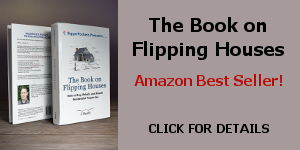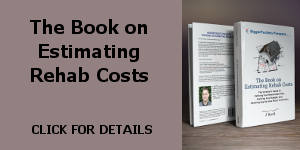In my last post, I discussed the two major investing philosophies among SFH investors: Cash Flow vs Appreciation.
As I mentioned at the end of that post, I tend to focus on the cash flow side of the investment, and hope that appreciation takes care of itself in the long run. So, that said, I wanted to provide a quick primer on how to determine if a house you are considering buying will cash flow, and to what extent. While I’ve already created a longer version of this for apartment buildings and other multi-unit properties, this post will be specifically relevant to single family houses…
For this primer, let’s assume we have found a house that we are considering buying to use as a rental, and are performing a cash flow analysis on it. Here’s the step-by-step process for doing so…
Step 1: Identify Income
In most cases, the total income your property is going to produce will come from the rent you are collecting. In some cases, you may also see income from things like providing storage space to tenants, charging for parking spaces, renting furniture to tenants, etc. Where that’s the case, that income should be added into the equation, but for this our hypothetical property, let’s just assume the total income will come from rent. Let’s further assume that we have done a survey of the local market, and we believe that this house that we are looking to buy will likely rent for $1000 per month.
So, our income is $1000/month (or $12,000/year), correct? Not quite…
Don’t forget that your property may not always be rented. You’ll need to find tenants when you first acquire the property and whenever tenants move out. Sometimes it could take a month or two (or more) to rent the place. Additionally, if a tenant moves out leaving the place in disarray, you may spend a month or two fixing it up. You need to figure out what percentage of the time the property is likely to be vacant, and consider that loss of income.
While determining an expected vacancy rate is not always easy, it should be possible to find local vacancy rates for your area. If not, ask other investors what type of vacancy rates they’ve seen with their properties. Lastly, consider that vacancy rates will be correlated to your rental price; if your rents are high for the market, you’ll probably have higher vacancy rates, as it will take you longer to find tenants willing to pay your price.
Suppose that for your property, you expect it to be vacant one month each year, on average. If that’s the case, your income is actually 11/12 of what your annual rent is. So, for our hypothetical property where were are charging $12,000 per year, after considering vacancy, our income is actually only $11,000 per year.
Step 2: Identify Expenses
There are a lot of things that contribute to the cost of owning a rental property, and you’re going to need to account for each of them. Here are the basic expenses you must consider (there are others, but this is a good start):
- Property Taxes
- Insurance
- Maintenance
- Utilities (often the landlord pays the water bill)
- Upkeep (lawn care, etc)
- Advertising (how are you going to find renters?)
- Administrative (do you need a book-keeper, attorney, CPA, etc?)
- Property Management (will you have someone else manage your prop?)
If you want to own a rental, you’ll need to be able to determine what each of these expenses will be. Some of these things — like taxes and insurance — can be accurately determined, and are easy enough to find out. But other things — like maintenance and administrative costs — can only be estimated and take some experience to be able to estimate accurately.
There are some general rules of thumb for estimating annual property expenses (which I discuss in a future post), the sake of this example, let’s assume that after doing all our research, we determine the total expenses for this property (including taxes, insurance, maintenance, etc) will be about $5,000 per year.
Step 2: Net Operating Income (NOI)
So, we now have our income ($11,000/year) and our expenses ($5,000/year) determined for our property. This is enough information to determine a very important value called “Net Operating Income,” (or NOI). The formula for NOI is:
NOI = Income – Expenses
Simply put, NOI is the amount of money you have left over after receiving all income and paying all expenses on your property. This is the money you have left over to pay your mortgage (also called debt service) and to provide you profit.
Let’s calculate our NOI for this property:
NOI = Income – Expenses = $11,000 – $4,000 = $7,000
Our NOI is $7,000 per year, so we have $7,000 left over after expenses to cover our debt service and our profit for the year.
Cash Flow
Cash flow is the amount of profit we have left over at the end of the year. Cash flow is basically figured out as such:
Cash Flow = NOI – Debt Service
We already know our NOI, so now we need to figure out our debt service. Debt service just means “mortgage payments” and to determine that, we need to figure out the purchase price of the property and the type of loan we will get to finance the purchase. For our example, let’s make the following assumptions:
- Purchase Price of House: $100,000
- Down Payment: 20%
- Loan Type: Fixed Rate for 30 Years
- Interest Rate: 6.00%
Based on those assumptions, our monthly mortgage payment would be $480/month, or $5760/year.
So, now we have the info we need to calculate our cash flow:
Cash Flow = NOI – Debt Service = $7,000 – $5,760 = $1,240
So, after all is said and done, our profit on this house is $1,240 per year.
That’s just over $100/month, which is about the minimum you should be looking for in a rental (any less and you risk losing money if any of your income or expenses assumptions prove too optimistic).
[googmonify]9523523149:center:468:60[/googmonify]




So …did you buy a house yet ?
A rental house? Nope, not yet…
I need two things to happen before I execute on the SFH business idea:
1) I need to decide whether I want to pursue this idea at all, and if so, to what extent. Originally, I had planned on pursuing just apartment investing, so this is somewhat of a side-track for me (though I’d still do apartments as well). I need to decide if this idea fits into my long-term plan, and to what extent (I’m big on having a plan if you can’t tell ;))
2) I need a partner who can help me get loans (to refi these houses). Currently, I have cash in the bank and great credit, but without income, the banks don’t want to bother with me. So, I’m working on finding at least one (if not more) partners, at least one of whom can co-sign to get loans
If you know anyone, let me know!
Jason, I’ve found your blog as I’m in SoCal and hoping to purchase a home soon to start my investment career. I’m currently working as a property manager dealing with condos, houses and apartments so I’m hoping my familiarity with properties will help me transition easily into an investor.
I’ve been reading since the beginning of your blog and think that this was a blog for you to start.
One question though. It says NOI is $11,000 – $4000 = $7000 per year. However, the example above had expense of $5000. I was wondering if this was just a typo or if you had gotten $4000 from some other calculation?
Thanks.
Hi Joon,
Yes, that was just a typo! Sorry about that…